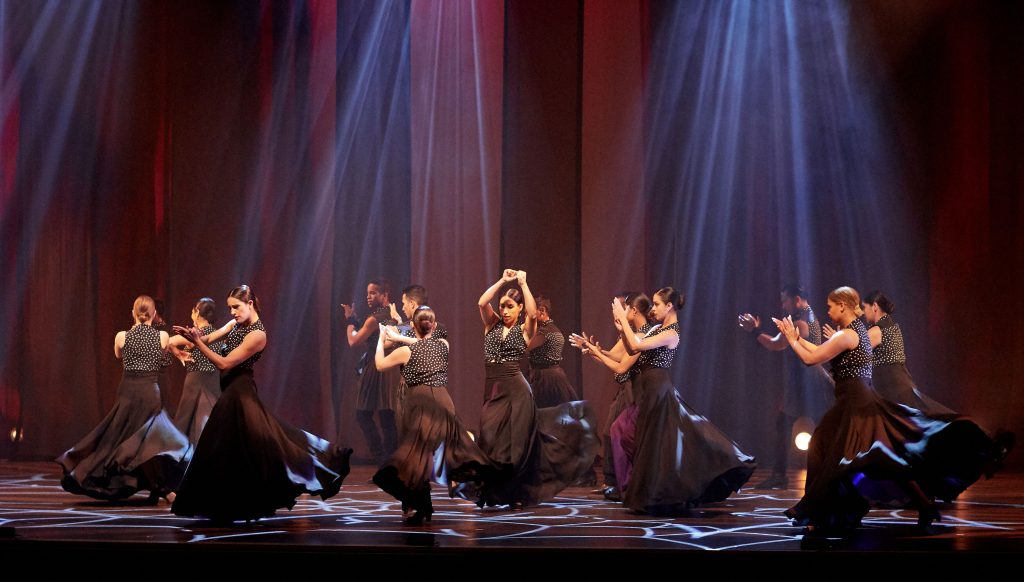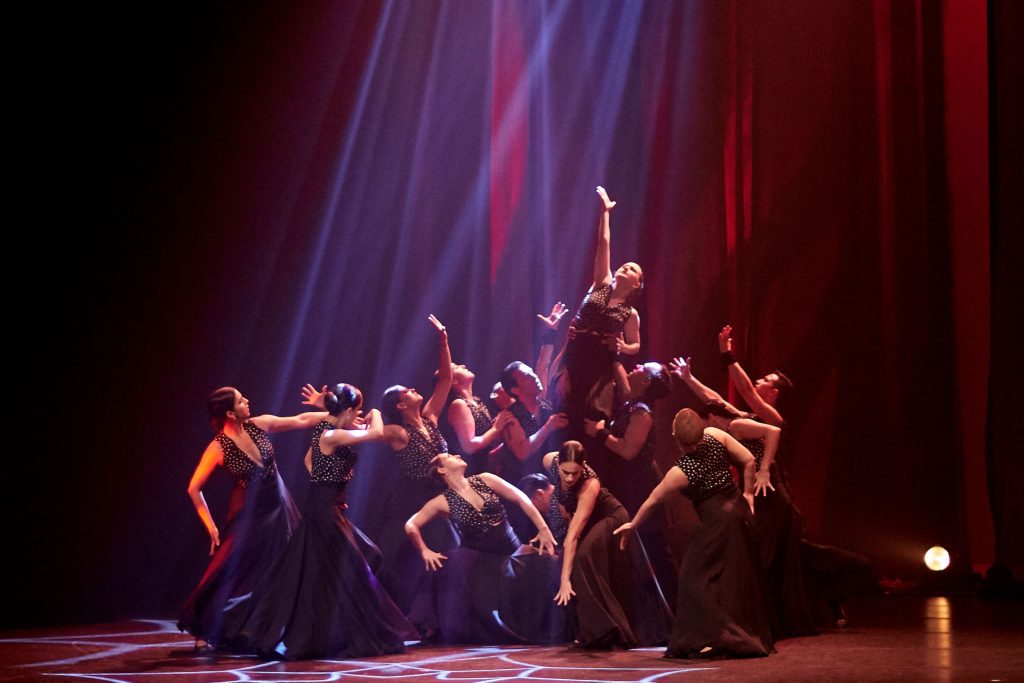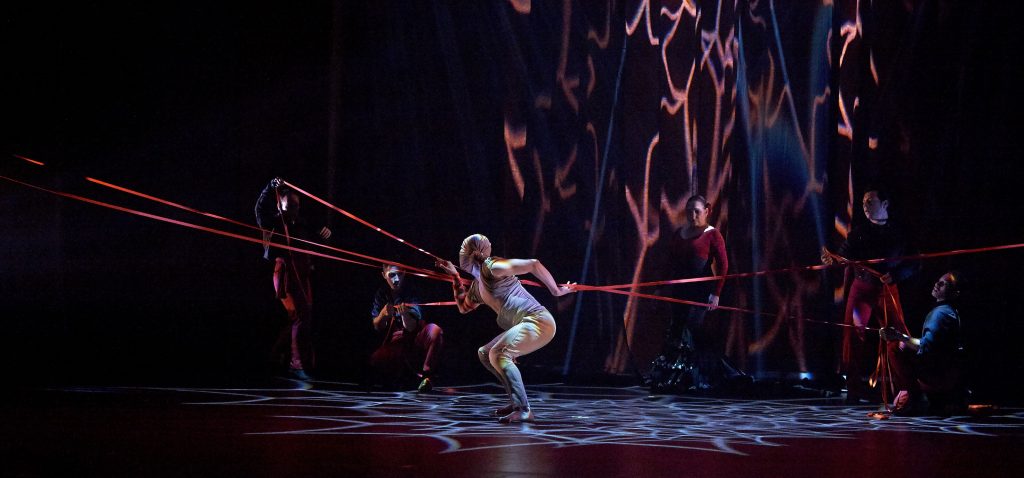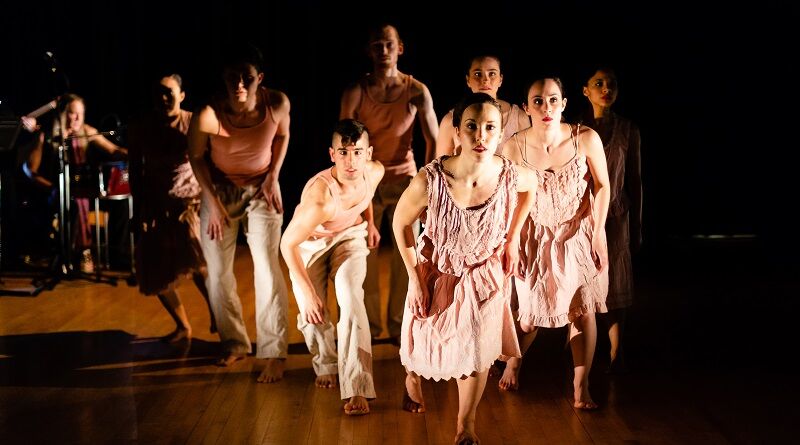
Ensemble Español Spanish Dance Theater made a big splash at Dance for Life in August with its show of artistic flair and ravishing precision. That they would be occupying the Auditorium stage again this month with an extended suite of dances made their show Saturday night highly anticipated. Based on the what they presented over the weekend, those high expectations were too low.
Ensconced in Chicago for over 40 years, the company’s fascinating approach to the craft of dance adds wonderful color to Chicago’s dance mosaic and warrants much greater name recognition and appreciation for this dynamic company.
Mystery, glamour and drama are words not often sprinkled over dance companies. With Ensemble Español, they seem to be mandatory. Founded by dance visionary Dame Libby Komaiko and using Northeastern University as its base, the company reflects Komaiko’s passion for the contributions Spanish dance brings to the arts and her zeal to insure those gifts are both valued and preserved here in the United States. The seven works presented during the Oct 4th performance schooled lovers of dance on the countless fascinating facets of flamenco.
Originating in northern Spain and with direct ties to the music and dance heritage of gypsies, flamenco hails from a past full of passion and drama. Elaborate hand gestures, strong rhythms, and footwork that accentuates its percussiveness with specially designed shoes all point to a dance form that’s bold and highly expressive. Perhaps some of its genius is the way it also weaves an almost ephemeral grace into its dance; making it even more enthralling. That grace may obscure flamenco’s folk origins; but its relentless vitality easily aligns flamenco to its beginnings.

Ecos de España (Echoes of Spain) displayed every ounce of that beauty and energy so typical of this distinctive dance form. Dame Komaiko designed the lighting as well as choreographed the piece that revels in the uniqueness of the Spain’s dance traditions. A full company production loaded with pageantry, dancers slipped in and out of exhilaration with female dancers, wearing costumes that accentuated the fluidity of the human body, using luxurious silk shawls as instruments of performance.
Another dance, inspired by the running of the bulls, Deshojando Flores (Stripping Flowers) dispensed with spectacle and focused on a different essence of dance. Performed by Crystal Ruiz and Olivia Serrano, individual solos soon meshed suddenly making it appear as if the pair were dancing as one. The two became mirror images of one another dancing in perfect synchrony only to later break apart and turn the dance into a duel.
Intensity may simply be an indelible characteristic of Spanish dance and its many variations. And nowhere was it more evident than in the spectacular Una Obra De Arte (A Work of Art). Celebrating the Farruca style of flamenco traditionally danced by men, first dancer Claudia Pizarro not only choreographed the classically episodic dance; she also designed the majestic red costume she wore as the work’s featured dancer. Mimicking the lean clean lines we associate with costumes worn by matadors, Pizarro’s tight waist length jacket and form hugging trousers signaled authority as well as elegance in a dance that rippled with suspense, technical prowess and dramatic vigor.

Lighting, noticeably, played a key role in magnifying the visual pleasure these dances created thanks to Dustin Derry’s bold approach to his craft. His inventiveness was evident in several works. Alluring but never dominating, Derry’s ingenious lighting techniques became vital backdrops to the dances. Much like the right music is essential to create the desired atmosphere and tone. Derry’s lighting was also indispensably beautiful in the world premiere of Azabache, where spotlights hit the floor encircling dancers in a thin line of pale neon green. The synergy between dance, lighting and music repeatedly came together to make the ensemble’s performances incessantly striking.
The company also used unexpected dramatic techniques to toy with the audience’s imagination. In Pasion Oculta (Hidden Passion), the sensual is made more exotic by initially making it blind. Danced by five couples, women first appeared with gauze covering their entire head like hoods; very similar to those used when hunting with birds of prey. They called to mind the surreal world of Salvador Dali’s art. Later in the dance, with head coverings removed, Pasion Oculta turned into a swirling dance of seduction in red.

Live and on stage with the performers, the evening’s music proved yet another rich highlight on a night that ostensibly had dance as its centerpiece. Both Ensemble Espanõl Spanish Dance Theater and Cerqua Rivera Dance Theater, who opened the show, were accompanied by superb musicians and vocalists.
For Cerqua Rivera, a contemporary dance company ambitious enough to investigate complex and emotional themes through dance, American Catracho mined the red-hot topic of immigration as viewed through Artistic Director’s Wildredo Rivera’s personal experience. Divided into four parts, American Catracho blended spoken word into the dance’s texture; which can be chancy and not always completely successful. American Catracho did succeed in displaying the commitment and artistry of its dancers and benefited from a superb jazz band performing music composed by Joe Cerqua, the company’s co-founder. With stellar Chicago musicians like Paul Cotton, Leandro Lopez Varady and Pharez Whitted contributing their skills to the project, the sweep and importance of the dance’s subject could more deeply be felt through music.
Ensemble Español Spanish Dance Theater
&
Cerqua Rivera Dance Theatre
October 4, 2019
The Auditorium Theatre
50 East Ida B. Wells Drive
Chicago, IL 60606